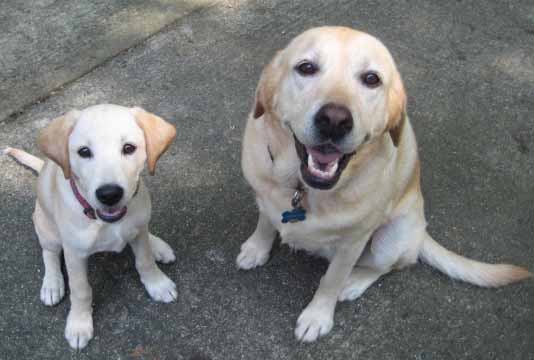
Huck Finn is a puppy. Half golden Labrador retriever, half Labradoodle, he’s a bundle of loose-limbed, silky-eared energy. Huck has a group of fans (I confess to being one) who adore him and his puppy-ness.
Huck Finn is a fan himself. He idolizes Ellie. Ellie is a Big Dog, a golden Lab. She’s a few years older than Huck and wise in the Ways of the Dog World. Huck tags along with Ellie and tries to copy her behavior. She seems happy to play the Big Dog role.
Ellie is a Big Dog, a golden Lab. She’s a few years older than Huck and wise in the Ways of the Dog World. Huck tags along with Ellie and tries to copy her behavior. She seems happy to play the Big Dog role.
My brother Bryan has owner-parent duties for both Huck and Ellie. Recently he has been teaching Huck how to swim. He takes Huck to the small lake near his home and wades out into shallow water with Huck in his arms. He places Huck’s back paws on the lake floor and lets him go with a little nudge.
The first few days, Huck only swam out about a foot. Then he turned around and hightailed it back into the solid safety of Bryan’s arms. The fifth day, I happened to go along with Bryan, Huck and Ellie.
While Huck got his swimming lesson, I walked out onto the dock and threw tennis balls into the lake for Ellie. Ellie loves chasing tennis balls. By the time the first ball left my hand, she was already halfway to the middle of the lake.
My brother had just let go of Huck when Ellie paddled by, on her way to retrieve the tennis ball. Huck eagerly took off after his idol. He swam halfway to the end of the dock. Then he realized where he was (oops) and turned around.
When he got back to Bryan, Huck was so excited he was grinning from ear to ear and wagging his entire body. That was the longest distance he had ever swum! Bryan, the proud dog parent, was beaming too.
Huck had learned by copying Ellie. People also learn from watching others. Behavior modeling is powerful stuff.
There’s a classic story about the US government’s efforts to change farm practices in the 1930s. First they tried informational pamphlets about conserving soil, but got few results. Then they got the idea to have extension agents teach the new practices to some willing farmers.
These trained farmers served as models for their neighbors, and the practices spread widely through the farm community. You could also use modeling to teach people how to recycle, garden, compost or adopt other desirable behaviors.
Ed. note: In honor of my 10th anniversary in business, I am updating and reposting some of the posts from my (now-defunct) Sage Enviro blog to make it easier for people to find them.